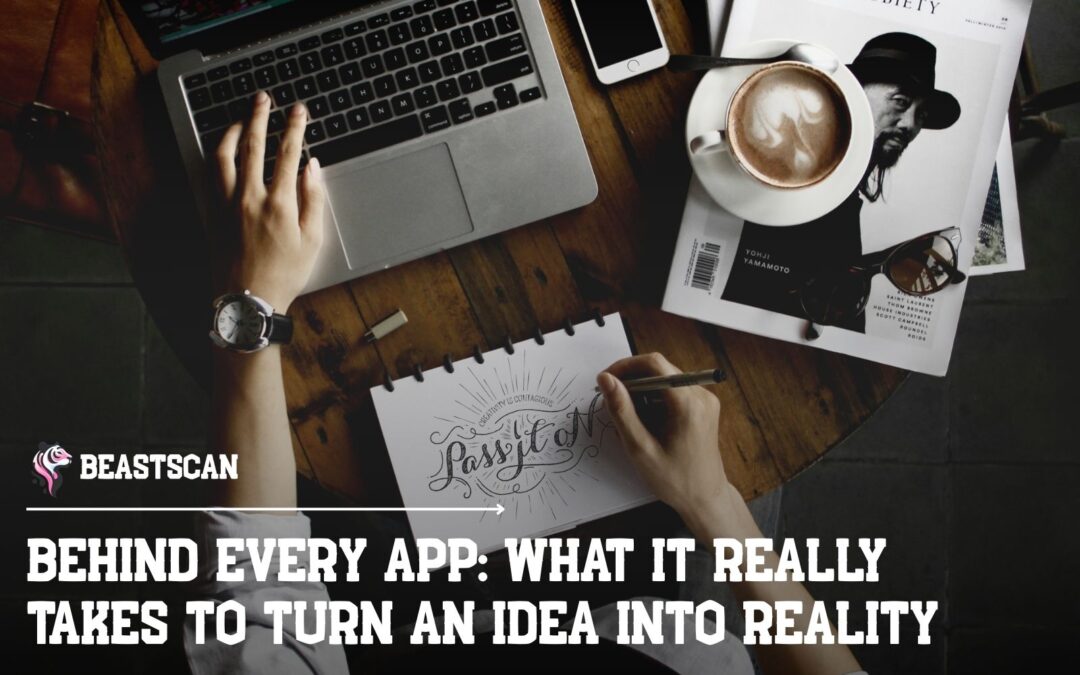We live in a world where new apps appear every day — a new website to shop from, a new mobile app to track your fitness, a new service to book appointments online.
At first glance, it seems almost effortless: someone has an idea, and suddenly, it’s live for the world to use.
But behind every successful app, there is a detailed, multi-step process that most people never see.
It’s not just about coding — it’s about planning, designing, testing, building, and constantly improving.
If you’ve ever thought, “I have a great idea for an app!” — this guide will give you a deeper, honest look at what it truly takes to bring that idea to life, whether it’s a web app, an Android app, or an iPhone app.
1. From Idea to Plan: Where It All Begins
Every app starts the same way — with an idea.
Maybe it’s a sudden spark of inspiration while waiting in line. Maybe it’s a problem you experience every day that makes you think, “There should be an app for this!”
At this stage, everything is still exciting.
But excitement alone doesn’t build successful apps.
Turning an idea into a clear plan is the first big step — and often one of the most important.

What Happens at This Stage?
You start asking questions to shape your idea into something real:
-
What problem does my app solve?
-
Who is it solving it for?
-
What will users actually do with the app?
-
What are the most important features it needs?
-
What would a user’s first experience look like?
Without answering these questions, it’s impossible for designers or developers to help you — because they won’t know what they’re building.
A Simple Example
Imagine you have the idea:
“I want to build an app for booking dog walkers.”
Good — that’s a start!
Now, let’s turn it into a plan by asking:
-
Is it for dog owners who need walkers?
-
Is it for walkers looking for jobs?
-
Should owners be able to see walker profiles, ratings, and prices?
-
Should walkers be able to accept or decline booking requests?
-
How will payments work? Inside the app? Cash?
-
What happens if a booking is canceled?
You can see how one simple idea (“booking dog walkers”) quickly opens up dozens of important questions.
Answering these before building saves huge amounts of time and money later.
Why This Stage Matters
If you skip proper planning, two bad things usually happen:
-
The project keeps changing. New ideas pop up mid-way, confusing everyone.
-
The costs explode. More work, more delays, more frustration.
On the other hand, when you have a clear, simple plan:
-
Developers can estimate the work and costs accurately.
-
Designers know what the screens need to show.
-
Everyone moves faster and smarter.
Key Tips for This Stage
-
Focus first on the most important feature.
(For the dog-walking app: booking a walker is the core feature. Messaging and ratings can come later.) -
Think like your user, not yourself.
(What would make their life easier? What would confuse them?) -
Keep it simple.
(The first version of an app — often called an MVP, or “Minimum Viable Product” — should solve one problem really well.)
Short Summary
✨ Great apps don’t start with coding — they start with clear thinking.
Before anything is built, the idea must be sharpened into a plan that’s simple, focused, and centered on the user’s needs.
2. Designing the Blueprint: Thinking Before Building
Once you have a clear idea and a plan, the next step is to design how everything will work.
This stage is like drawing the blueprints before building a house.
You wouldn’t start pouring concrete without knowing how many rooms you need — and the same goes for apps.

What Happens at This Stage?
At this point, we’re no longer just talking about what the app should do.
Now we figure out:
-
What screens or pages does the app need?
-
What should users see when they first open the app?
-
Where do buttons lead?
-
What happens after a user completes an action (like booking, buying, sending)?
It’s about laying out the structure of the app — and making sure it’s easy and logical for users to move through it.
A Simple Example
Let’s stay with our dog-walker booking app idea.
You would probably need:
-
A home screen showing available dog walkers
-
A profile page for each walker (with ratings, prices, and photos)
-
A booking page where owners pick a date and time
-
A payment page
-
A confirmation page after booking
You might also need:
-
Login/Signup pages
-
A profile page for the dog owner
-
A calendar page for the walker to see bookings
You don’t have to design exactly how everything looks yet — but you must map out what screens exist and how they connect.
Tools Used
At this stage, designers or product teams often create:
-
Wireframes: basic, black-and-white layouts of each screen (no colors, just boxes showing where things go).
-
User flows: diagrams showing how users move from one step to another.
These wireframes are like rough sketches — they help everyone agree on the structure without getting distracted by colors or images yet.
Why This Stage Matters
Without a proper blueprint:
-
Users might get lost or confused inside the app.
-
Important features could be forgotten.
-
Developers might waste time guessing where things should go.
Good blueprinting ensures that everything has a place and that the app makes sense from the first click to the last.
A Real-World Story
A startup once skipped this step for their restaurant ordering app.
They jumped straight into coding and forgot to think through a major detail:
-
Customers couldn’t edit their order once they clicked “pay.”
This small mistake frustrated users — and fixing it later cost them months of extra work.
If they had mapped the user journey properly at the start, they would have caught it before building anything.
Key Tips for This Stage
-
Think step-by-step: Imagine you’re using the app for the first time. What happens next? And after that?
-
Less is more: Fewer screens, fewer steps = happier users.
-
Don’t get stuck on colors and design yet: Focus first on what needs to exist and how it flows together.
Short Summary
✨ Good apps feel natural and easy because someone took the time to design a smart blueprint.
Before you build, you need to know what you’re building and how users will move through it.
3. Choosing the Right Tools: Setting the Foundation
Now that you know what you want to build and how it should work, the next important step is choosing the tools to build it with.
Think of this step like deciding if you’re building a house out of wood, brick, or steel.
The materials you choose affect how strong, fast, and flexible your house will be — and it’s the same with apps.

What Happens at This Stage?
The team now decides:
-
How the app will be built
-
Which technologies (programming languages, frameworks, platforms) will be used
-
What services (like payment providers, databases, or cloud hosting) will be needed
-
How the app will work across different devices (computers, phones, tablets)
These decisions are usually made by developers and technical leads, but they are hugely important for the entire project.
A Simple Example
Let’s go back to our dog-walker booking app.
You might ask:
-
Should it be a website that works on phones and computers?
-
Should it be a mobile app that people download from the App Store and Google Play?
-
Should it be both?
If you want a website, developers might use tools like:
-
HTML, CSS, and JavaScript for the frontend
-
A backend language like Node.js or PHP to handle bookings and user accounts
-
A database like MySQL to store walker profiles and bookings
If you want a mobile app, developers might:
-
Build natively (one app for iPhone using Swift, and another app for Android using Kotlin)
-
Or use cross-platform tools like Flutter or React Native to build one app that works on both iPhone and Android at the same time
👉 Choosing between these options affects:
-
How fast the app is to build
-
How much it costs
-
How easy it is to maintain and update later
Why This Stage Matters
Picking the wrong tools can cause huge problems later:
-
The app might run slowly or crash often
-
Updates could become very expensive
-
Features you need in the future might be hard or impossible to add
On the other hand, choosing the right technology early saves time, money, and stress.
It makes sure your app can grow smoothly as your business grows.
A Real-World Story
A small fitness startup decided to build a mobile app only for iPhone, because they thought “everyone uses iPhones.”
Later, when Android users wanted the app too, they had to build a second app from scratch — doubling their costs and delaying their expansion by months.
If they had chosen a cross-platform tool like Flutter in the beginning, they could have supported both platforms with the same app from day one.
Key Tips for This Stage
-
Think about the future: Even if you only need a simple website now, will you want a mobile app later? Will you want to add chat, video, or other complex features?
-
Trust your developers: Choosing the right tools is a technical decision — it’s smart to listen to experts who think long-term.
-
Don’t just pick “the newest” technology: Pick what’s stable, well-supported, and right for your project.
Short Summary
✨ Choosing the right tools is like laying the foundation of a house.
A strong foundation means your app can grow, stay reliable, and adapt to new needs — without falling apart later.



4. Bringing It to Life: The Development Phase
This is the moment many people imagine when they think about “building an app” — developers sitting behind screens, typing lines of mysterious code.
But the reality is a lot more structured (and a lot more interesting).
The development phase is where your carefully planned idea starts becoming a real, working product.
What Happens at This Stage?
The work is usually divided into two big areas:
1. Frontend Development (The “Face” of the App)
This is what users see and interact with:
-
Buttons, forms, menus
-
Pages and screens
-
Animations and visual effects
Example:
In the dog-walker app, when a dog owner browses walker profiles or fills in a booking form — that’s all frontend work.
2. Backend Development (The “Brain” of the App)
This is everything that happens behind the scenes:
-
Storing data (like user accounts, bookings, payments)
-
Sending emails or notifications
-
Handling logins and security
-
Making sure everything works properly when lots of people use the app at the same time
Example:
When the booking form is submitted, the backend saves the booking to the database, sends a confirmation email, and notifies the walker — all without the user seeing any of it happening.
How It’s Usually Built
Depending on the project size, the team often works like this:
-
Build one small part (like the login system)
-
Test it
-
Build the next part (like the booking system)
-
Test again
This method, called iterative development or Agile development, helps catch mistakes early and keeps the project flexible.
👉 It’s not like building a tower where you can’t change anything later — it’s more like building with Lego blocks:
You can adjust things as you go.
A Simple Example
Let’s say in the dog-walker app:
-
Developers first build a simple page to list walkers.
-
Then they build the profile page.
-
Then they add a booking button.
-
Then they connect payments.
Each piece is tested and improved before moving to the next.
Why This Stage Matters
Without careful and skilled development:
-
Apps can feel slow, buggy, or unsafe.
-
Users might get frustrated and delete the app.
-
Systems might crash if too many people use it at once.
Good development is what makes an app reliable, fast, and enjoyable — not just for the first user, but for the thousandth user too.
A Real-World Story
A new online marketplace launched quickly without properly building their backend.
When they got featured in a magazine and thousands of people tried to visit, the app crashed for hours — and they lost valuable momentum.
Building the app properly from the start would have meant surviving their big break, instead of falling apart under pressure.
Key Tips for This Stage
-
Trust the process: Development can look slow at first — it takes time to build solid foundations.
-
Ask for demos: Good developers will often show you small working versions (called “staging versions”) along the way.
-
Expect changes: As things come to life, you’ll spot improvements you didn’t think of before — and that’s normal!
Short Summary
✨ The development phase is where your idea becomes something real people can touch, click, and use.
It’s a careful process of building, testing, and improving — and it’s what separates a “cool idea” from a working app.
5. Testing: Finding Problems Before Users Do
By now, your app is built.
It has real buttons, real features, and real screens.
It’s tempting to think: “Let’s launch it!”
Not so fast.
Before you open the doors to the public, you need to test everything carefully — because once real users encounter a bug or a problem, their trust can be lost in seconds.
Testing is where you find and fix mistakes before your customers do.

What Happens at This Stage?
In testing, the goal is simple:
Try to break the app before anyone else can.
Testers and developers:
-
Click every button
-
Try to break forms by entering weird data
-
Test the app on different devices (big screens, small screens, old phones)
-
Use the app with slow internet to see if it still works
-
Check if private information stays safe
-
See what happens when two people book the same walker at the same time (for example)
Testing finds the little cracks before they turn into big disasters.
A Simple Example
Imagine you launch the dog-walker booking app without testing properly.
A dog owner tries to book a walk for 3:00 PM — but due to a hidden bug, the system books it for 3:00 AM instead.
The walker gets confused. The owner gets angry.
You lose trust immediately.
Good testing would have caught that bug before any real users ever saw it.
Types of Testing
There are different types of testing, depending on what you need:
-
Functional Testing:
Does each feature work like it’s supposed to? -
Usability Testing:
Is the app easy to use? Can people figure it out without getting frustrated? -
Performance Testing:
Does the app stay fast when lots of people are using it at once? -
Security Testing:
Can hackers steal data? Are passwords safe? -
Cross-Device Testing:
Does the app work on iPhones, Android phones, tablets, and computers?
Each kind of testing protects you from a different kind of problem.
Why This Stage Matters
Testing isn’t just about avoiding embarrassment.
It’s about protecting your users’ experience, your reputation, and your future growth.
An app with lots of bugs will quickly get:
-
Bad reviews
-
Angry emails
-
Refund requests
-
Loss of users
On the other hand, an app that works well from the start builds trust, loyalty, and word-of-mouth growth.
A Real-World Story
An e-commerce app launched without proper mobile testing.
On Android phones, the “Buy Now” button didn’t work — users could browse but couldn’t actually make a purchase.
By the time they realized, they had lost thousands of dollars in missed sales.
All because of one missing test.
Key Tips for This Stage
-
Never skip testing to save time: Fixing problems after launch is 10x harder and 10x more expensive.
-
Test like a real user: Click around without thinking like a developer. Try things the “wrong way” on purpose.
-
Be patient: Good testing takes time, but every bug you catch now is a future customer you save.
Short Summary
✨ Testing is your safety net.
It’s the phase where you catch mistakes before they hurt your users, your brand, and your success.
A well-tested app feels reliable, trustworthy, and professional from the very first click.
6. Launching the App: Opening the Doors to the World
After all the planning, building, and testing, it’s finally time for the big moment:
Launching your app into the real world.
It’s an exciting milestone — but it’s also a careful process.
A great launch isn’t just pressing a button.
It’s about making sure your app is ready, your team is ready, and your users are excited and supported.

What Happens at This Stage?
Launching the app involves several important steps:
-
Setting up servers and hosting (for websites and web apps)
-
Publishing the app to app stores (for Android and iPhone apps)
-
Configuring domains and security certificates (so users connect safely)
-
Making backups in case something goes wrong
-
Monitoring the app’s behavior in real time after launch
-
Announcing the launch through marketing or communication channels
It’s about moving from a private, “in-development” version of your app to a live version that’s available to anyone, anytime.
A Simple Example
For the dog-walker app:
-
If it’s a website, you would set it live at www.bookmydogwalker.com.
-
If it’s a mobile app, you would submit it to the Apple App Store and Google Play Store.
Important:
For mobile apps, both Apple and Google have review processes.
They check your app for:
-
Bugs
-
Content violations
-
Privacy policy compliance
-
Proper use of payments
Approval can take a few days — or sometimes longer if issues are found.
Why This Stage Matters
The first impression users get from your app is powerful.
If the app:
-
Loads slowly
-
Crashes
-
Looks broken on some devices
-
Has confusing instructions
…users will often never come back.
You only get one “first launch.”
That’s why careful preparation — and sometimes even a soft launch (a smaller, private launch before telling the whole world) — is smart.
A Real-World Story
A new online event app launched with big advertising campaigns — but forgot to test how the app would handle many people joining at once.
During the first few hours, the app slowed down, crashed repeatedly, and left early users frustrated.
The result?
Bad reviews flooded in before they even had a chance to fix the problems.
If they had done a smaller, private launch first (also called a “beta launch”), they could have caught and fixed these problems without damaging their brand.
Key Tips for This Stage
-
Double-check everything before launch: Test payments, signups, logins, email confirmations, and notifications.
-
Plan for support: If something goes wrong on day one, how will users get help?
-
Have a backup plan: If the server goes down or the app gets rejected by Apple, what’s Plan B?
-
Expect small surprises: Even the best teams miss tiny bugs. What matters is how quickly you fix them.
Short Summary
✨ Launching an app is a huge achievement — but it’s not the finish line.
It’s the start of your app’s life in the real world.
Success depends not just on building the app, but on how carefully and thoughtfully you launch it.





7. Growing, Improving, and Maintaining
You’ve launched your app.
It’s live. People are using it. Success? Yes — but the journey isn’t over.
In fact, this is just the beginning.
A great app isn’t something you launch once and forget about.
It’s something you care for, improve, and grow over time — just like a living thing.
What Happens at This Stage?
After launch, real users start interacting with your app:
-
They will find bugs you didn’t catch during testing.
-
They will suggest new features you never thought about.
-
They will use the app differently than you expected.
Some things will work beautifully.
Some things will need adjusting.
New needs will appear as your audience grows.
At this stage, your focus shifts from building to listening, fixing, improving, and expanding.
A Simple Example
In the dog-walker booking app:
-
After a few weeks, you notice users keep messaging walkers directly to negotiate prices.
-
You realize you need to add a messaging feature inside the app to make communication easier.
-
Also, some users report that the calendar view is confusing on smaller phone screens — so you decide to redesign it.
None of these needs were obvious at the beginning.
But now that real people are using the app, you can see where to improve.
Areas to Focus on After Launch
-
Bug Fixes:
Even after testing, new bugs pop up. Quickly fixing them keeps users happy. -
Performance Improvements:
As more people use your app, you might need to make it faster and more reliable. -
Security Updates:
New threats appear all the time. Keeping user data safe means regularly updating systems. -
Feature Enhancements:
Based on user feedback, you can add new features, improve existing ones, or simplify things. -
Marketing and User Growth:
Building the app was only half the battle — now you have to promote it, attract users, and keep them engaged.
Why This Stage Matters
Many apps fail after launch — not because they were bad ideas, but because the creators stopped working on them.
User expectations grow over time:
-
They expect bugs to be fixed quickly.
-
They expect apps to improve and feel modern.
-
They expect communication and support if something goes wrong.
👉 An app that stands still will slowly lose users to newer, faster, or better competitors.
A Real-World Story
A promising budgeting app launched with great success but didn’t update for a full year.
Meanwhile, banking apps improved their mobile features dramatically.
By the time the small app finally released updates, most of their users had already moved to better alternatives.
In today’s fast-moving world, standing still is falling behind.
Key Tips for This Stage
-
Listen to your users: Feedback is gold. Negative reviews, support emails, or even casual comments on social media can guide your improvements.
-
Update regularly: Small improvements often are better than waiting a year for a massive update.
-
Stay secure: Always prioritize security updates, even if they aren’t visible to users.
-
Measure and learn: Use simple analytics tools to see what features people use most — and where they drop off.
Short Summary
✨ A successful app isn’t just built — it’s grown and nurtured over time.
By listening, improving, and adapting, you keep your users happy, stay ahead of competitors, and build an app that truly lasts.
Conclusion: Building an App – What It Really Takes
By now, you’ve seen that creating an app — whether it’s a web app, Android app, or iPhone app — is not just about having a good idea.
It’s about careful planning, thoughtful design, skilled development, patient testing, a smart launch, and ongoing improvements.
But here’s an honest question:
Can one person do all of this?
In theory — yes.
There are talented individuals called full-stack developers who can design, code, test, and launch small apps on their own.
For very simple apps or early “prototypes” (basic working versions), one person can absolutely start the journey.
In practice, however — as things grow, the demands usually grow too:
-
You need specialized design to make the app beautiful and user-friendly.
-
You need strong backend skills to handle scaling, security, and performance.
-
You need testers to find hidden issues.
-
You need marketing and support to reach and serve users.
👉 That’s why serious apps usually involve a team — not because it’s impossible alone, but because it’s faster, smarter, and more reliable with the right experts involved.
Starting Small and Scaling Up
One smart strategy is to start small:
-
Begin with one skilled person (or a tiny team).
-
Focus on the most important features only (your MVP — Minimum Viable Product).
-
Launch early, learn from real users, and improve based on feedback.
As your app gets more users and more complexity, you can gradually grow your team:
-
Bring in a dedicated designer
-
Hire a backend specialist
-
Add a marketer or support agent
Many of the world’s biggest apps started this way:
-
A few people doing everything they could in the early days.
-
Building steadily, adapting, learning, and growing.
Final Thoughts
Building an app is a big project — but it’s not an impossible one.
With a clear plan, the right mindset, and the right people at the right time, you can turn an idea into something real, valuable, and lasting.
Whether you’re starting with just yourself, a small team, or a larger group, remember:
-
Clarity beats complexity.
-
Progress beats perfection.
-
Listening beats guessing.
Every great app you use today once started as a small idea — built carefully, grown thoughtfully.
Yours can too.

